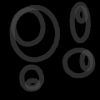Options
Correct answer this easy question?
in CCNA & CCENT
This question is from wendell odoms cisco press INTRO book. Chapter 3 Quiz question 2.
Which of the following are part of the functions of OSI Layer 2 protocols?
a. Framing
b. Delivery of bits from one device to another
c. Addressing
d. Error detection
e. Defining the size and shape of Ethernet cards
I picked A and D (Framing and Error detection) because ethernet has a FCS for detecting if error occured. But the answer given in the book is only A.
Which of the following are part of the functions of OSI Layer 2 protocols?
a. Framing
b. Delivery of bits from one device to another
c. Addressing
d. Error detection
e. Defining the size and shape of Ethernet cards
I picked A and D (Framing and Error detection) because ethernet has a FCS for detecting if error occured. But the answer given in the book is only A.
Comments
-
Options
 Pash
Member Posts: 1,600 ■■■■■□□□□□
The question is a little vague but there again many cisco questions are there to fool you in the real exam, tbh id say that factual questions are actually the hardest to answer compared to the proper troubleshooting questions.
Pash
Member Posts: 1,600 ■■■■■□□□□□
The question is a little vague but there again many cisco questions are there to fool you in the real exam, tbh id say that factual questions are actually the hardest to answer compared to the proper troubleshooting questions.
I would say as the question doesn't hint towards the use of switching (ie store and foward switching), then negate error detection as an answer and stick with framing.DevOps Engineer and Security Champion. https://blog.pash.by - I am trying to find my writing style, so please bear with me. -
Options
 rossonieri#1
Member Posts: 799 ■■■□□□□□□□
MaddogZ wrote:This question is from wendell odoms cisco press INTRO book. Chapter 3 Quiz question 2.
rossonieri#1
Member Posts: 799 ■■■□□□□□□□
MaddogZ wrote:This question is from wendell odoms cisco press INTRO book. Chapter 3 Quiz question 2.
Which of the following are part of the functions of OSI Layer 2 protocols?
a. Framing
b. Delivery of bits from one device to another
c. Addressing
d. Error detection
e. Defining the size and shape of Ethernet cards
I picked A and E (Framing and Error detection) because ethernet has a FCS for detecting if error occured. But the answer given in the book is only A.
A and C (C? -> MAC)
E is correct - but it was more on PPP functionality ( which is also true in L2)the More I know, that is more and More I dont know. -
Options
 james_
Member Posts: 97 ■■□□□□□□□□
OK, maybe you are reading an outdated version of the CISCO Press book?
james_
Member Posts: 97 ■■□□□□□□□□
OK, maybe you are reading an outdated version of the CISCO Press book?
My answers for the same question are:
a. Framing
b. Delivery of bits from one device to another
c. Logical Addressing
d. Error Recovery
e. Defining the size and shape of Ethernet cards
Notice c and d.
Logical (not physical) addressing refers to IP addresses, Layer 3.
Error Recovery (not detection) generally refers to the Transport layer, and TCP
So out of the above, only a. Framing is applicable.
Hope this helps! -
Options
 Pash
Member Posts: 1,600 ■■■■■□□□□□
james_ wrote:OK, maybe you are reading an outdated version of the CISCO Press book?
Pash
Member Posts: 1,600 ■■■■■□□□□□
james_ wrote:OK, maybe you are reading an outdated version of the CISCO Press book?
My answers for the same question are:
a. Framing
b. Delivery of bits from one device to another
c. Logical Addressing
d. Error Recovery
e. Defining the size and shape of Ethernet cards
Notice c and d.
Logical (not physical) addressing refers to IP addresses, Layer 3.
Error Recovery (not detection) generally refers to the Transport layer, and TCP
So out of the above, only a. Framing is applicable.
Hope this helps!
exactly, remember host to host layer 4 is your error recovery.DevOps Engineer and Security Champion. https://blog.pash.by - I am trying to find my writing style, so please bear with me. -
Options
 MaddogZ
Member Posts: 15 ■□□□□□□□□□
Im reading the 2004 edition of cisco press INTRO.
MaddogZ
Member Posts: 15 ■□□□□□□□□□
Im reading the 2004 edition of cisco press INTRO.
Back to my question its says ERROR DETECTION not error recovery which i know is Transport layer function. However error detection can be done in layer 2 because of the FCS. -
Options
 Spudage
Member Posts: 56 ■■□□□□□□□□
Goto the Cisco Press website and follow the links to the errata for your particular version of the book. You'll probably find that they have corrected it since the book was published.
Spudage
Member Posts: 56 ■■□□□□□□□□
Goto the Cisco Press website and follow the links to the errata for your particular version of the book. You'll probably find that they have corrected it since the book was published.
For technical books it's always a good idea to look up the errata. It can mean the difference between understanding a topic and not having a clue (due to errors)












